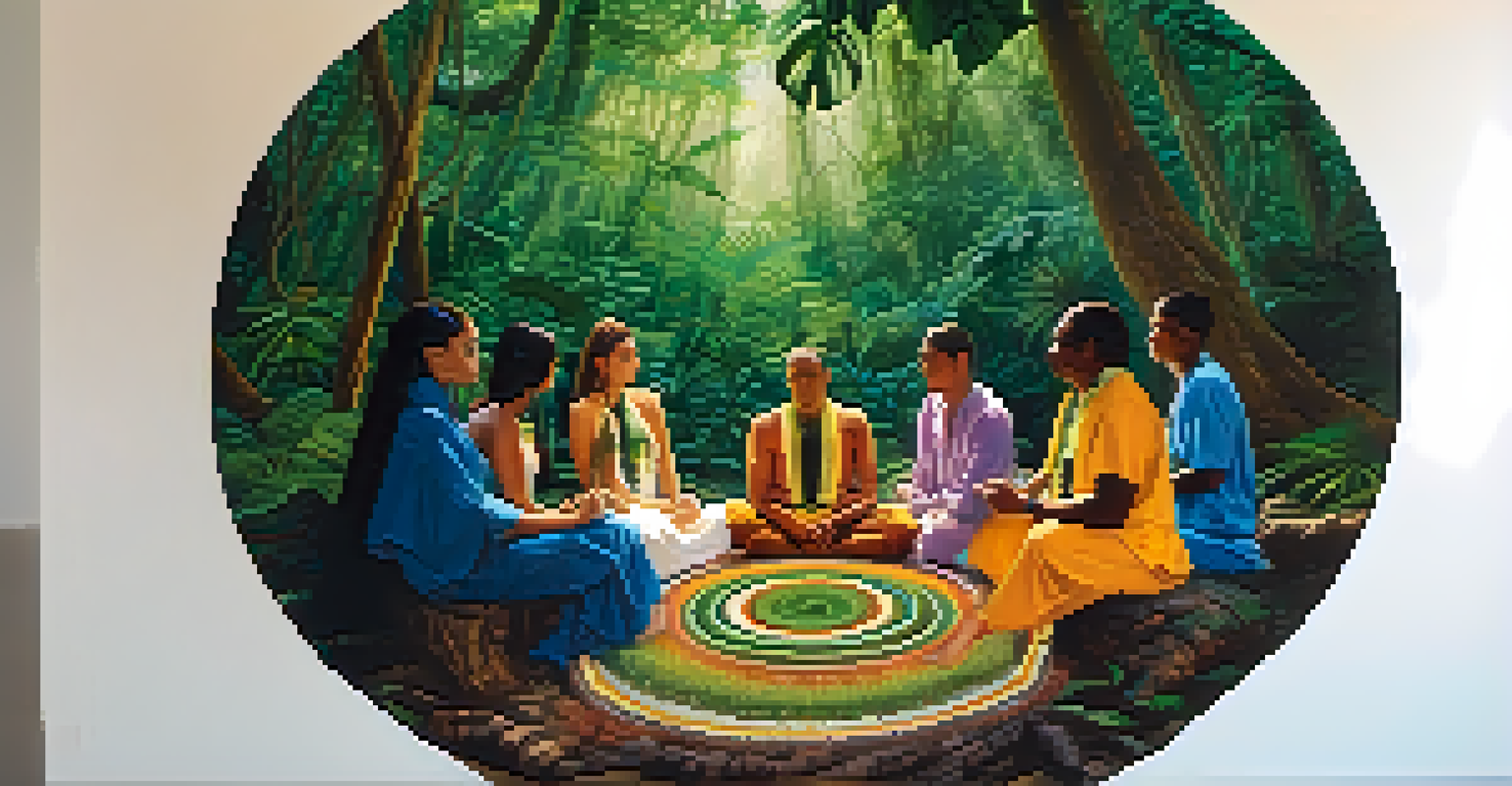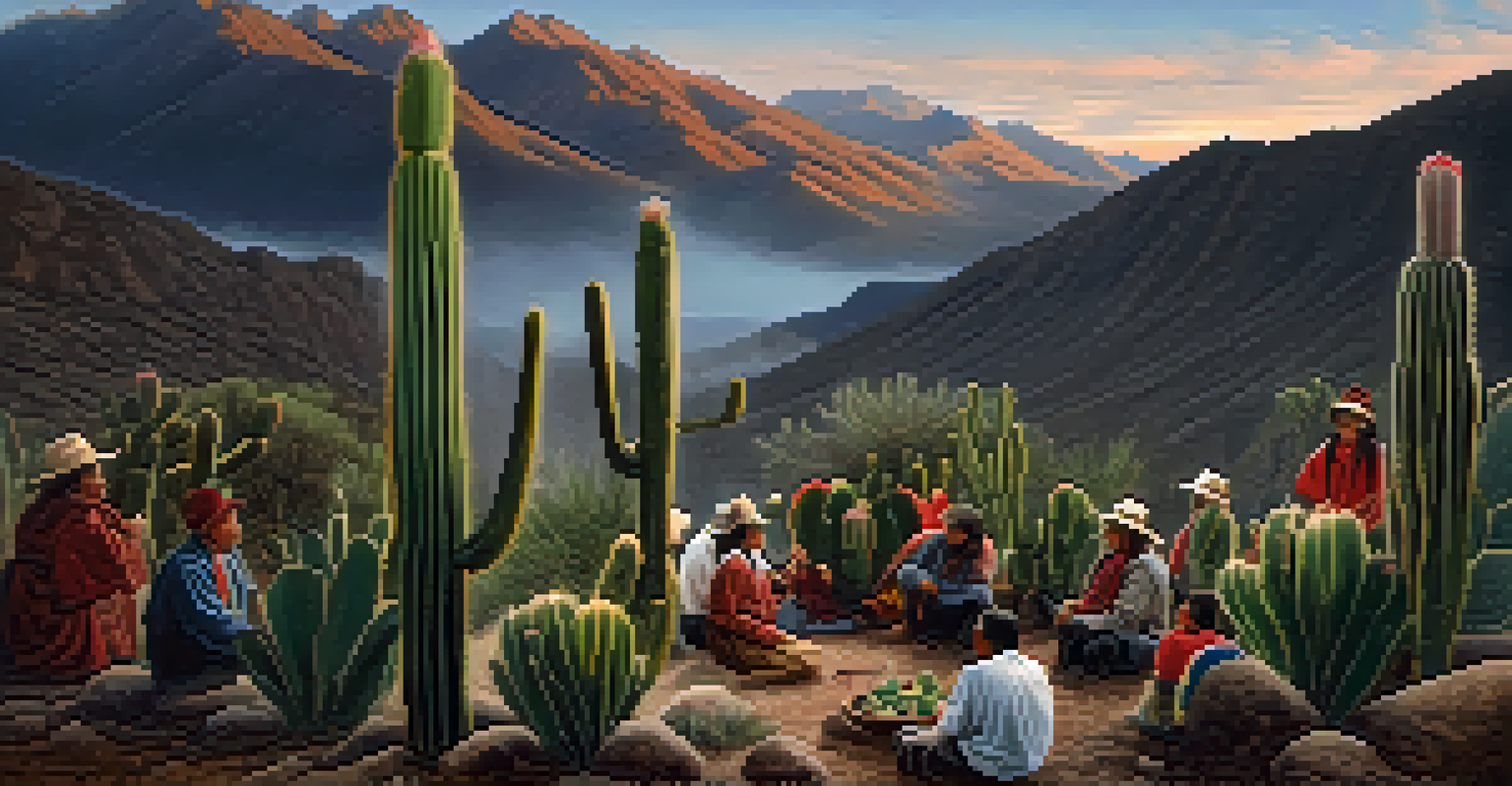Entheogens in Indigenous Cultures: A Critical Overview

Introduction to Entheogens in Indigenous Practices
Entheogens are substances used in religious or spiritual contexts to induce altered states of consciousness. In many Indigenous cultures, these natural compounds play a vital role in rituals and healing practices. They are often regarded as sacred, believed to facilitate communication with spiritual realms or ancestors.
Entheogens are not just tools for personal exploration; they are integral to community identity and cohesion.
For example, the use of peyote among Native American tribes is deeply embedded in their spiritual traditions, serving as a medium for visions and guidance. Similarly, Amazonian tribes utilize ayahuasca ceremonies to foster community bonding and personal healing. These practices highlight the profound respect Indigenous peoples have for these substances.
Understanding the significance of entheogens involves more than just their psychoactive effects; it requires recognizing their cultural context and the values they embody. This sets the stage for a deeper exploration of how these substances are intertwined with identity, spirituality, and community.
Historical Perspectives on Entheogens
The use of entheogens in Indigenous cultures dates back thousands of years, with evidence found in archaeological sites across the Americas. Artifacts, including pottery and rock art, often depict ritualistic practices involving these substances, showcasing their integral role in ancient societies. This historical backdrop provides insight into the continuity of these traditions.

For instance, the Maya civilization is known to have used mushrooms during rituals, as evidenced by ancient texts and artifacts. Such historical connections emphasize that the relationship between Indigenous peoples and entheogens is not a modern phenomenon but rather a longstanding tradition with deep roots.
Entheogens in Indigenous Cultures
Entheogens are sacred substances integral to Indigenous rituals, fostering spiritual connections and community identity.
However, the arrival of colonial powers significantly disrupted these practices, often leading to the suppression of Indigenous beliefs. Understanding this historical context is crucial for recognizing the resilience of these cultures and their continued reliance on entheogenic practices as forms of resistance and revitalization.
Cultural Significance of Entheogens
In many Indigenous cultures, entheogens are not merely tools for personal exploration; they are integral to community identity and cohesion. These substances often facilitate communal rituals that strengthen social bonds and reaffirm cultural values. This collective aspect of entheogenic use highlights the importance of shared experiences in shaping community identity.
To navigate these ethical waters, it's essential for individuals to approach entheogens with humility and a willingness to learn.
Take the example of the San Pedro cactus in Andean cultures, where its consumption during rituals fosters a sense of unity and connection among participants. These gatherings are often characterized by storytelling, music, and shared visions, reinforcing cultural narratives and communal ties.
Moreover, the spiritual insights gained during these ceremonies can contribute to a deeper understanding of one's place within the community and the cosmos. This interconnectedness emphasizes that entheogens serve as bridges between the individual, the community, and the larger universe.
Modern Adaptations and Revivals
In recent years, there has been a resurgence of interest in entheogens, particularly among Indigenous communities seeking to reclaim their traditions. Many have begun to revive ancient practices, integrating them with contemporary cultural expressions. This revival not only honors ancestral wisdom but also addresses modern issues such as mental health and community disconnection.
For instance, some tribes are re-establishing traditional peyote ceremonies as a means of healing from historical trauma and fostering resilience. These adaptations illustrate the dynamic nature of culture, showing how Indigenous peoples are reinterpreting their practices to meet current needs while preserving their heritage.
Ethical Use and Cultural Respect
As interest in entheogens grows, it is essential to navigate their use with respect for Indigenous cultures and their traditions.
This modern renaissance also opens up dialogues about the ethical use of entheogens in broader society, prompting questions about cultural appropriation and the commercialization of sacred practices. Engaging with these issues requires a respectful understanding of Indigenous knowledge systems and their contemporary relevance.
Ethical Considerations in Entheogen Use
As interest in entheogens grows, so do concerns about ethical usage, particularly regarding cultural appropriation. Many Indigenous communities view their traditional practices as sacred and are wary of outsiders commodifying these rituals without understanding their significance. This creates a complex landscape where respect for cultural heritage must be balanced with the desire for personal exploration.
For example, workshops and retreats that offer ayahuasca experiences often attract non-Indigenous participants, raising questions about who gets to access these sacred practices. Critics argue that without proper context and respect, such experiences can trivialize deeply held beliefs and traditions.
To navigate these ethical waters, it's essential for individuals to approach entheogens with humility and a willingness to learn. Engaging with Indigenous voices, supporting their rights, and acknowledging the cultural significance of these substances is crucial for fostering respectful relationships.
The Role of Entheogens in Healing Practices
In Indigenous cultures, entheogens are often employed in healing rituals, addressing both physical and spiritual ailments. These practices are rooted in the belief that health is a holistic concept, encompassing the mind, body, and spirit. By facilitating altered states, entheogens can help individuals confront personal traumas and foster emotional healing.
For instance, ayahuasca ceremonies are frequently used to treat addiction and mental health issues, providing participants with insights that can lead to transformative healing experiences. The communal aspect of these ceremonies also plays a role in reinforcing support networks, further aiding recovery.
Healing through Holistic Practices
Indigenous healing rituals utilizing entheogens emphasize the interconnectedness of mind, body, and spirit, contrasting with conventional Western medicine.
This holistic approach contrasts sharply with conventional Western medicine, which often separates physical and mental health. By integrating entheogens into healing practices, Indigenous cultures remind us of the importance of viewing health as an interconnected web of experiences.
Conclusion: The Enduring Legacy of Entheogens
The relationship between entheogens and Indigenous cultures is rich and multifaceted, reflecting deep spiritual, historical, and social connections. As we explore this complex legacy, it's essential to recognize the resilience of these cultures in the face of challenges and their ongoing commitment to preserving their traditions. This enduring legacy offers valuable lessons about the importance of community, spirituality, and the natural world.
Moreover, as the world becomes increasingly interested in the therapeutic potential of entheogens, it is crucial to approach these substances with respect for their cultural origins. By supporting Indigenous rights and practices, we can foster a more equitable dialogue about the role of entheogens in both healing and spirituality.

Ultimately, engaging with the traditions surrounding entheogens invites us to reflect on our own beliefs and practices, encouraging a deeper understanding of the interconnectedness of all life. The journey into the world of entheogens is not just about altered states but about the profound connections that bind us to each other and the Earth.